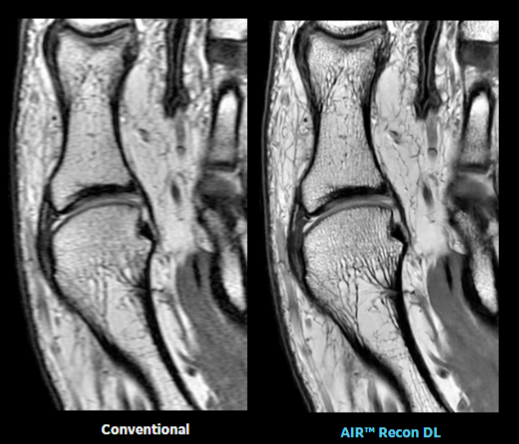GE’s Deep Learning Image Reconstruction Technology Hits 2 Million Patient Mark
 GE Healthcare’s AIR Recon DL deep learning image reconstruction solution has now been used on more than 2 million patients globally, fundamentally shifted the balance between image quality and scan time in MR.
GE Healthcare’s AIR Recon DL deep learning image reconstruction solution has now been used on more than 2 million patients globally, fundamentally shifted the balance between image quality and scan time in MR.
The company made the announcement at the 2022 ISMRM annual meeting, where it is highlighting the continued expansion of its state-of-the-art AIR Recon DL technology across the totality of its 1.5T, 3.0T and 7.0T MR product portfolio. GE also announced the continued expansion of AIR Recon DL, which was developed on GE Healthcare’s Edison intelligence platform, to include the motion-insensitive sequence PROPELLER and 3D applications, pending regulatory clearances. With this expansion, AIR Recon DL covers nearly 90% of clinical MR sequences, regardless of the anatomy being scanned.
“Since we first saw the power of our AI-based deep learning image reconstruction technology, AIR Recon DL, we knew it could have a massive clinical impact. So, we went all in…” says Jie Xue, President & CEO, Magnetic Resonance, GE Healthcare. “We developed it for all anatomies; we made it work on all field strengths – 1.5T, 3.0T and 7.0T – and most importantly, we made it available not only on our latest scanner models, but also on all our installed GE MR scanners dating back 20+ years. From first time MR users to experienced MR researchers, we want every GE MR customer – regardless of their scanner’s age – to benefit from today’s groundbreaking AI-based technology.”
These advancements have proved especially valuable for those who struggle to remain still during MR exams, such as pediatric, neurodegenerative and geriatric patients. Shreyas Vasanawala, MD, PhD, Chief of Pediatric Radiology & Di-rector of MRI, Lucile Packard Children’s Hospital at Stanford shares, “Patients don’t necessarily know that this feature is being turned on or off. But they wind up just seeing that their appointment has gone quicker, and for a lot of children we’re just able to get the scan done before they’ve reached their limit of cooperation.”
In addition to a faster and more comfortable patient experience, AIR Recon DL helps to provide more confident patient diagnosis. Hollis Potter, MD, Chair of Radiology, Hospital for Special Surgery comments, “There is more de-tail in the image, especially at a lower matrix. In some conventionally processed MR images, the trabecular bone pattern is poor, the nerves are blurred and there is a lot of noise in the image. With AIR Recon DL, the difference is striking.”
AIR Recon DL offers greater efficiency to healthcare systems. The AI-based algorithm has been the subject of more than 12 international, peer-reviewed scientific journal publications covering various anatomies, with conclusions underlining the reliability, efficiency, and utility of deep learning-based enhancement for quantitative imaging across care pathways. Radiology departments today continue to face multiple challenges – including increased workload demands due to a backlog of cases resulting from COVID-19, steadily growing patient volumes, and industry-wide staff shortages and burnout. As a result, there is clear need for broad access to MR clinical solutions that can reduce time-to-diagnosis, improve patient throughput, and enhance the patient and staff experience.
In addition to AIR Recon DL, GE is also highlighting: oZTEo, an MR bone imaging solution that provides CT-like image contrast for both soft tissue assessment and bone imaging within the same exam; MotionFree Brain on its SIGNA PET/MR to provide significant improvement in quantitative accuracy – especially for small brain lesions – and a more comfortable scanning experience for patients; and SIGNA Evo, which is designed to enable healthcare systems to transform their legacy 3.0T and 1.5T 60 cm narrow bore MR systems to premium, state-of-the-art 3.0T and 1.5T, 70 cm wide bore systems. Both MotionFree Brain and SIGNA Evo are pending CE Marking.
Related Articles
Citation
GE’s Deep Learning Image Reconstruction Technology Hits 2 Million Patient Mark. Appl Radiol.
May 9, 2022